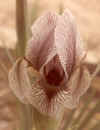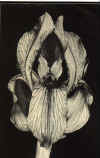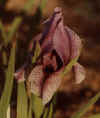I. korolkowii
|
Collected by Eduard August von Regel in Turkestan, 1872, and accorded species status on the basis of his records. So named because a live specimen had been sent to St. Petersburg by General Korolkow in 1870. It is the best known and undoubtedly most popular of all of the regelia species. The ground color ranges from white through cream to purplish, usually covered with delicate veining of maroon to brown and a small arrow-shaped signal. Range from south-central Asia to northeastern Afghanistan. Many variants have been identified. In 1888, Sir Michael Foster described four varieties: concolor, Leichtliniana, venosa, and violacea. In 1913, Dykes added the observation: "Of late years, many seedlings of this species have been raised and endless forms have arisen, some of which are intermediate between the above-mentioned. It is impossible to name every variety, although all are so different from any other species, that it is difficult to mistake a specimen of I. Korolkowi for anything else." This is the sole regelia species used in the development of the diploid regeliocyclus. It has entered the gene pool of both diploid and tetraploid arils, and become a significant contributor to the gene pool of today's arilbreds. Because of the way these have been distributed down through the years, there has been a great deal of debate regarding which ones are variants in the botanical sense and which are selected cultivars. I have chosen to firmly straddle the fence on this issue, omitting any such designation when it is unclear. Click on the thumbnails to see larger versions of these pictures. |
|
| I. korolkowii Atropurpurea. (M. Van Waveren & Sons, 112). The description suggests that this was a darker version of Foster's concolor, but it appears to have been lost. |
Photo Not Available |
| I. korolkowii "Brown & Green". Not registered, but offered by Rainbow gardens as early as 1951. No photo can do this one justice. The iridescent signal appears olive-green through dark greenish-brown to chocolate-brown, depending on the angle at which the light hits it. Widely used in hybridizing. The unanswered question is whether Austin used this name for a selected clone or distributed multiple clones of the same variant. In any case, there were several "Brown & Green" clones in distribution during the '70s & '80s that matched Austin's description, whidh could be seen to differ slightly when grown side-by-side. |
 |
| I. korolkowii Var. concolor. Described by Foster as rather smaller than the type, with segments broader and shorter, and the venation almost wholly obscured by a general violet or purple color. Used by early hybridizers, so it has contributed to the gene pool -- but it appears to have been lost. |
Photo Not Available |
| I. korolkowii Incarnata. Recognized by the Aril Society's 1976 Checklist Committee, but no description was published. |
Photo Not Available |
| I. korolkowii Var. Leichtliniana. Described by Foster as: "standards and falls are nearly pure creamy-white, with fine unobtrusive veins, and the "signal" is of the deepest, almost black, purple." Alhough it was widely used by early hybridizers, it appears to have been lost. |
Photo Not Available |
| I. korolkowii "Pink". Not registered, but offered by Rainbow gardens as early as 1951. Described as having a creamy-pink ground with maroon veins. Unfortunately, I must conclude that it has been lost. None of the rhizomes I obtained in the '70s & '80s bloomed true and I have never seen a color photo of it. This has been on many a hybridizer's "Most Wanted" list and would indeed be a treasure if it reappeared in commerce.. |
 |
| I. korolkowii typica. This designation became popular in the '70s and '80s, and was applied to many clones that were unmistakably advanced-generation I. korolkowii but not one of the recognized variants. |
 |
| I. korolkowii Var. venosa. Foster described it as having much more conspicuous veining than the other three he listed (concolor, Leichtliniana, venosa, and violacea). Unfortunately, it appears to have been lost. |
Photo Not Available |
|
I. korolkowii Var. violacea. Foster described it as having the olive-green or brown of the type replaced by violet or puce. Rainbow Gardens described it as a "Rare variant, white ground heavily flushed and veined red-violet. Best seed-setter of the regelias. More oncogelias have descended from this than any other." |
|
|
Many reference books provide additional information concerning this species. See the Reference Lists, or return to Regelia Species. |
|
History | Hybridizing | Library | List of Cultivars | Photo Gallery
